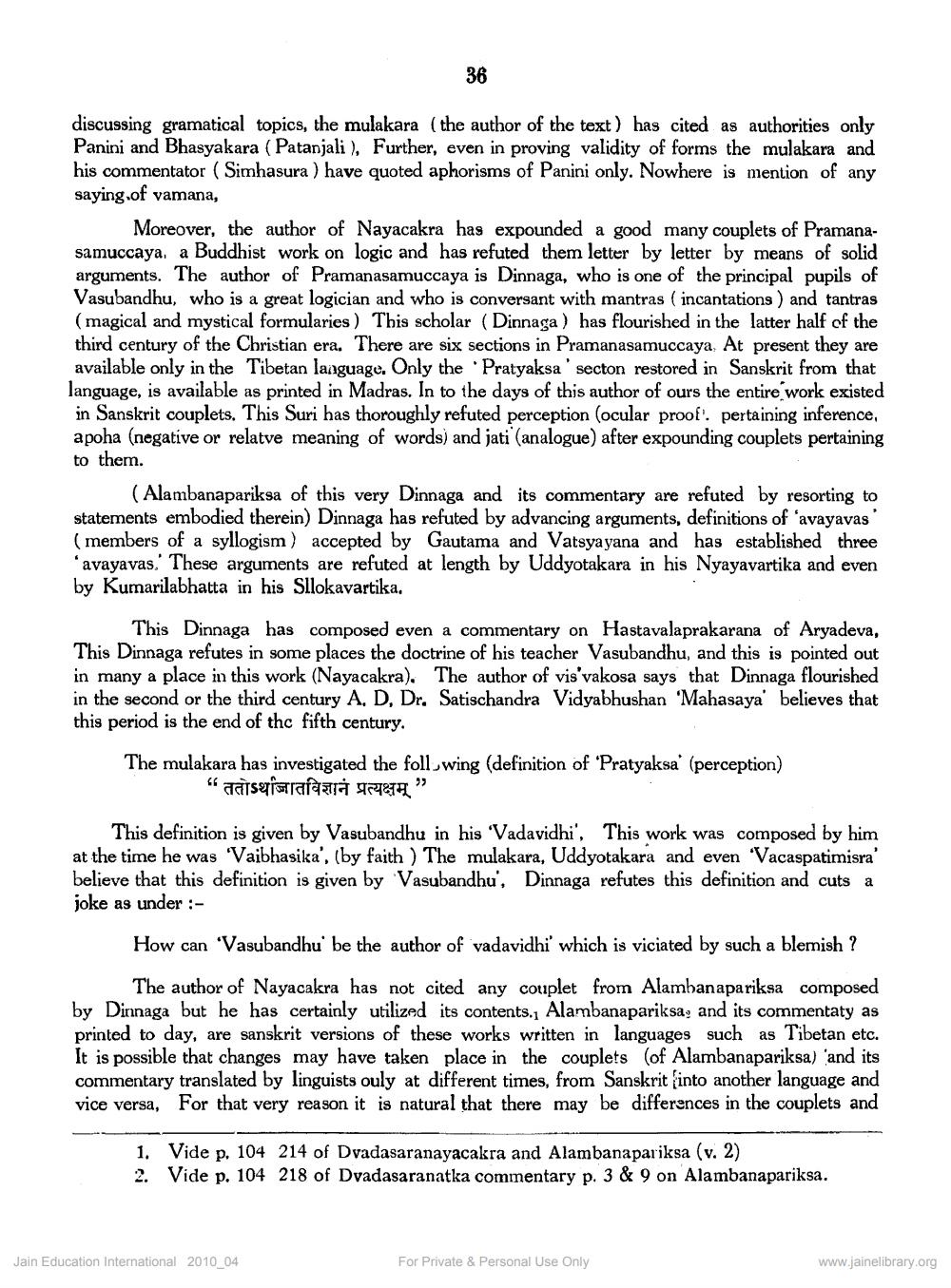________________
36
discussing gramatical topics, the mulakara (the author of the text) has cited as authorities only Panini and Bhasyakara (Patanjali), Further, even in proving validity of forms the mulakara and his commentator ( Simhasura ) have quoted aphorisms of Panini only. Nowhere is mention of any saying.of vamana,
Moreover, the author of Nayacakra has expounded a good many couplets of Pramanasamuccaya, a Buddhist work on logic and has refuted them letter by letter by means of solid arguments. The author of Pramanasamuccaya is Dinnaga, who is one of the principal pupils of Vasubandhu, who is a great logician and who is conversant with mantras ( incantations ) and tantras (magical and mystical formularies) This scholar (Dinnaga ) has flourished in the latter half of the third century of the Christian era. There are six sections in Pramanasamuccaya. At present they are available only in the Tibetan language. Only the Pratyaksa' secton restored in Sanskrit from that language, is available as printed in Madras. In to the days of this author of ours the entire work existed
in Sanskrit couplets. This Suri has thoroughly refuted perception (ocular proof'. pertaining inference, apoha (negative or relatve meaning of words) and jati (analogue) after expounding couplets pertaining to them.
(Alambanapariksa of this very Dinnaga and its commentary are refuted by resorting to statements embodied therein) Dinnaga has refuted by advancing arguments, definitions of 'avayavas' (members of a syllogism ) accepted by Gautama and Vatsyayana and has established three 'avayavas. These arguments are refuted at length by Uddyotakara in his Nyayavartika and even by Kumarilabhatta in his Sllokavartika,
This Dinnaga has composed even a commentary on Hastavalaprakarana of Aryadeva, This Dinnaga refutes in some places the doctrine of his teacher Vasubandhu, and this is pointed out in many a place in this work (Nayacakra). The author of vis'vakosa says that Dinnaga flourished in the second or the third century A, D, Dr. Satischandra Vidyabhushan Mahasaya' believes that this period is the end of thc fifth century.
The mulakara has investigated the foll wing (definition of ‘Pratyaksa (perception)
" ततोऽजातविज्ञानं प्रत्यक्षम्"
This definition is given by Vasubandhu in his 'Vadavidhi', This work was composed by him at the time he was Vaibhasika', (by faith ) The mulakara, Uddyotakara and even Vacaspatimisra' believe that this definition is given by Vasubandhu', Dinnaga refutes this definition and cuts a joke as under :
How can "Vasubandhu' be the author of vadavidhi' which is viciated by such a blemish ?
The author of Nayacakra has not cited any couplet from Alambanapariksa composed by Dinnaga but he has certainly utilized its contents., Alambanapariksa, and its commentaty as printed to day, are sanskrit versions of these works written in languages such as Tibetan etc. It is possible that changes may have taken place in the couplets (of Alambanapariksa) and its commentary translated by linguists ouly at different times, from Sanskrit into another language and vice versa. For that very reason it is natural that there may be differences in the couplets and
1. Vide p. 104 214 of Dvadasaranayacakra and Alambanapariksa (v. 2) 2. Vide p. 104 218 of Dvadasaranatka commentary p. 3& 9 on Alambanapariksa.
Jain Education International 2010_04
For Private & Personal Use Only
www.jainelibrary.org




